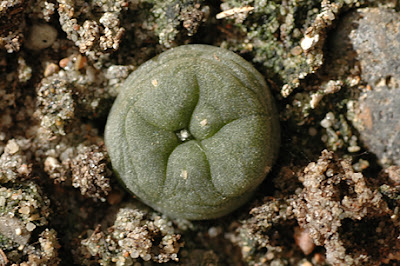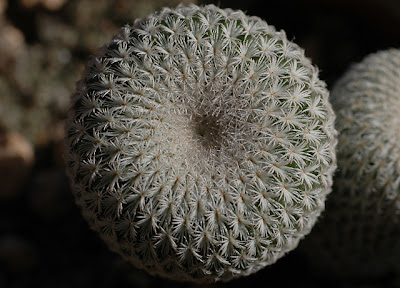Since 2004 I’ve experimented with growing Lophophora, Epithelantha, and Acharagma in an unheated greenhouse in Denmark. The winter this year has been damp but not very cold - the coldest temperature registered in the coldhouse was -5C (23F) – so even the L. diffusa plants are doing great. 
Lophophora williamsii (SB 854; Starr Co, Texas)
The L. williamsii plants (sown May 2004) are thriving in the coldhouse. The epidermis is glaucous bluish-green, much truer to the type than plants grown in my windowsill. All my cold grown Lophs are wrapped in horticultural fleece during winter – not so much because of the temperature, but to avoid attacks from various critters. This kind of damage is not a problem with the spine covered species.
Lophophora diffusa (Higuerillas, Queretaro, Mexico)
In 2005 I sowed L. diffusa and L. decipiens to grow in the coldhouse. Especially the L. diffusa plants had a hard time last winter and only 2 survived. Both are now doing fine and are developing the typical yellowish-green epidermis. 
Lophophora decipiens
L. decipiens is not a “good” species; it’s probably just a cultivar form of Lophophora fricii (I couldn’t obtain any collection data for these seeds either when I bought them). Anyway, the plants are doing well and are getting ready to go 8-ribbed at an age of two.
I’m growing both “regular” Epithelantha micromeres and Epithelantha micromeris v. gregii. The gregii variety seems to be a faster grower than the regular micromeres; it also has a very beautiful coverage of spines, as illustrated below.
Epithelantha micromeris v. greggii (Cuesta la Muralla, Coahuila, Mexico)
Epithelantha micromeris v. greggii – closeup
All of the Epithelantha plants made it through this winter without damage.
Saturday, March 31, 2007
Lophophora and Epithelantha - experiments in cold hardiness II
Labels:
Epithelantha,
Experiments in cold hardiness,
Lophophora decipiens,
Lophophora diffusa,
Lophophora williamsii
Monday, March 05, 2007
Seed starting Lophophora, Ariocarpus, and Epithelantha
The last couple of days I’ve been busy starting the next generation of plants from seed. One of the more interesting lophs this year is a variety of Lophophora williamsii originating from El Oso, Coahuila, Mexico. According to The genus Lophophora – Kaktusy Special 2, 2005 this variety forms massive clusters with individual heads measuring up to 15 cm (5.9'') in diameter! Unfortunately it seems the El Oso site is severely threatened by agricultural activities.

Lophophora williamsii - El Oso, Coahuila (picture taken from The genus Lophophora – Kaktusy Special 2, 2005)
I’ve sown the following Lophophora seeds this year:
- Lophophora diffusa v. koehresii (RS 1182; El Sabino, San Luis Potosí)
- Lophophora diffusa ssp. kubesai (JJH 0010892; Puente Mezquitio, Querétaro)
- Lophophora fricii (RS 404B; Viesca, Coahuila)
- Lophophora williamsii (MMR 89; El Oso, Coahuila)
- Lophophora williamsii (RS 428A; Cuatro Ciénegas, Coahuila)
 Lophophora diffusa ssp. kubesai
In addition to the Lophophora seeds I also started a handful of Ariocarpus from seed:
Lophophora diffusa ssp. kubesai
In addition to the Lophophora seeds I also started a handful of Ariocarpus from seed:
- Ariocarpus fissuratus (JDL 26; Hot Springs, Big Bend, Texas)
- Ariocarpus fissuratus (VVZ 204; Terlingua, Texas)
- Ariocarpus fissuratus (VVZ 205; North of Alpine Texas)
- Ariocarpus kotschoubeyanus v. macdowellii (RS 134; Hipolito, Coahuila)
- Epithelantha micromeris (JM 101; Sitting Bull Canyon, New Mexico)
- Epithelantha micromeris v. gregii (MMR 179; El Oso, Coahuila)
Labels:
Ariocarpus,
Epithelantha,
Lophophora diffusa,
Lophophora fricii,
Lophophora koehresii,
Lophophora williamsii,
Seed starting
Subscribe to:
Comments (Atom)
All Time Most Popular Posts
-
Lophophora williamsii (peyote) populations have diminished in large areas of South Texas where peyoteros harvest the cactus for ceremonial ...
-
On various occasions I've been asked what growing media I'm using for my cactus plants. I don't have a set soil mix recipe as su...
-
Below is a list of retailers/nurseries selling cactus seed and plants. I've only listed vendors I've done business with. If you ar...
-
Most cacti are easily grown from seed - and with a little patience and care they can be grown into beautiful plants. Lophophora williamsi...
-
In last month’s post on the troubled Texan peyoteros I referred to Anderson’s article on the peyote situation in Texas. Given the importanc...
-
Yet another slightly off topic and probably not entirely politically correct post, but I couldn’t help noticing the similarity of my monstr...
-
Flowering stand of San Pedro cacti (Trichocereus pachanoi) To me the main draw of the San Pedro cactus ( Trichocereus pachanoi (syn. Ech...
-
In the June 2008 issue of the Cactus & Co magazine Jaroslav Šnicer, Jaroslav Bohata, and Vojtěch Myšák described a new Lophophora spec...
-
There seems to be an increased focus on the alarming Texas peyote situation. A couple of weeks ago the Houston Press published a mournful, i...
-
I spent two weeks working in Delhi, India during January. I had one weekend off and had planned to spend it in Delhi at my own leisure, but ...


















